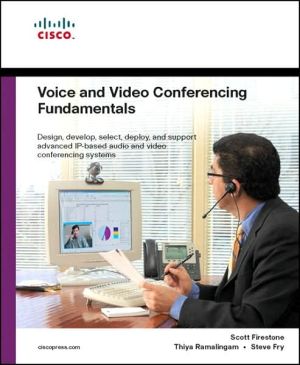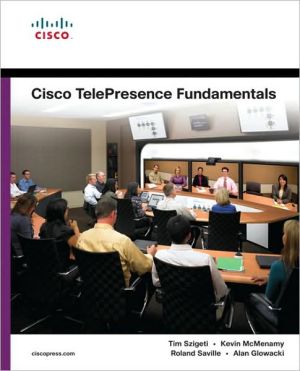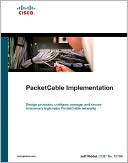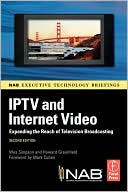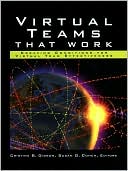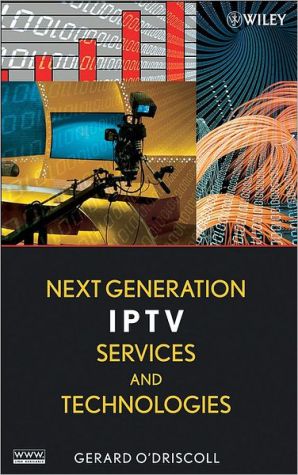e-Video: Producing Internet Video as Broadband Technologies Converge
Today, we are standing on the brink of an Internet revolution. As compression technology, streaming techniques, and transmission lines grow in efficiency, speed, and capacity, Internet video is fast becoming both viable and inevitable. \ \ \ This resource-packed guide to producing, encoding, editing, compressing, and serving video over the Internet lets you in on this coming "killer app." It presents the current tools and technologies that make Internet video possible, and reveals likely...
Search in google:
As compression technology, streaming techniques, and transmission lines grow in efficiency, speed, and capacity, Internet video is fast becoming both viable and inevitable. This resource-packed guide to producing, encoding, editing, compressing, and serving video over the Internet lets you in on this coming "killer app." It presents the current tools and technologies that make Internet video possible, and reveals likely future developments, allowing you to make knowledgeable investments in technology and equipment that anticipate these trends. The book covers bandwidth requirements for video delivery-from low-end broadband to the ultimate high-speed HDTV transmission. It follows the video preparation and production process, demonstrating various software tools for developing, encoding, and editing content. You will also find in-depth information on the state-of-the-art in video compression and streaming technology. In addition, the book explains how the networks and servers currently support Internet video, and describes future developments in the works. You will learn about such specific topics as: e-commerce, educational, and entertainment opportunities The desktop video production cycle Data compression fundamentals and algorithms Streaming video codec standards RealVideo and other software tools from such vendors The transition from electronic routers and switches to optical nodes Innovations in network caching and data storage on the Internet Filled with examples, experience-based techniques, and available tools, this book serves both as a compendium of information and a hands-on tutorial. The code and video demos for all the examples are included on the accompanying CD-ROM. Booknews Computer engineer Alesso describes such technologies as digital encoding and editing, compression and streaming, and high-capacity data transmission and argues that their convergence makes video over the Internet both viable and inevitable. He addresses either webmasters who want to get into video or video producers wanting to get onto the web. The CD-ROM contains example code and streaming video demonstrations; software can be downloaded from an associated web site. There is no bibliography. Annotation c. Book News, Inc., Portland, OR (booknews.com)
PREFACE: \ Overview\ If you can recall the special effects from Star Wars, then you can already appreciate the impact of video.\ Someday, when you go on-line to make a purchase, you'll see a video demonstration of the product in action. If it needs assembly, instead of piecing it together from a single sheet of indecipherable instructions, you'll go back on-line for step-by-step video instructions. And you'll be able to ask questions and receive answers in real-time.\ Someday, you will attend school classes only if you want to because much of your education and training will be available on Web video.\ Someday, video will be everywhere. Someday. But not today!\ Today the delivery bandwidth just isn't there yet. But, don't be concerned. Broadband technologies are converging at breakneck speed, and higher quality video is on the way. But what will you do in the meantime?\ If you knew just how TV, phone, and cable broadband technologies were converging, couldn't you make better multimedia choices? For example, have you ever tried to add a video product demo to your Web site, only to be frustrated by hardware and software incompatibilities? Are you trying to start a video Web-based business, but find yourself thwarted by server and network limitations? Have you found your video application software development plans stymied by the chaos of technology standards?\ Good news! This book offers powerful insights into the synergism between producing Internet video and technology convergence. This book will enable you to make the most knowledgeable investments in hardware and software to produce Web video and anticipate futuretrends. It provides the necessary How-To information for putting video on your business Web site today, without the hazard of imminent obsolescence.\ So, if you need to make the best decisions today to prepare for that someday, this book is for you.\ Background\ When Thomas Alva Edison invented the phonograph in 1877, he gave us the freedom to select and play music in our own home at our own convenience. It took another century until the VCR became widely available and we gained the ability to similarly select and play videos. But Edison's contribution wasn't just the invention of the phonograph, or the light-bulb, or even the 1,093 inventions for which he received a patent. He helped found an industry, the industry of electric power and analog appliances that transformed the twentieth century in both the home and the factory.\ Now another industrial transformation is underway, the digital revolution. It can be traced to Tim Berners-Lee's creation of the graphical interface, which allowed the Internet to become a popular communication tool. As a result, within only six years the Internet had reached 80 million users. This is astonishing compared to past communication media successes.\ The Internet had existed for decades mostly for scientific workers and the military. When in 1989, while working at the European Particle Physics Laboratory (CERN) in Geneva, Berners-Lee proposed a global hypertext system he called the World Wide Web. It could link more than just text--it could link graphics, sound, and video to create an entire hypermedia system. Instead of a single database, the basis for his World Wide Web would be the Internet, the vast network of networks around the world.\ Over the next couple of years, Berners-Lee and his collaborators laid the groundwork for the Web, inventing and refining the HyperText Transfer Protocol (HTTP) for linking Web documents, the Hypertext Markup Language (HTML) for formatting Web documents, and the Universal Resource Locator (URL) system for addressing Web documents. These days, most of us reach the Web through commercial browsers, such as Netscape Navigator or Internet Explorer. The first contact most Internet users had with streaming data started with Progressive Network's RealAudio releasing its RealAudio Server and client programs. RealAudio started playing as soon as the user chose a selection. It was a cross-platform program that could be played from Windows, Unix, and Mac systems.\ The first true streaming videos ran during 1994 over the experimental Mbone (Multicast Backbone) network. This protocol is a form of Internet Protocol (IP) multicasting, which replicates streaming videos to thousands of servers. Access to these events was initially confined to users with high-end Sun workstations. The primary media server distributed its signal to other repeater servers on the network.\ Streaming media started with the Internet's first streaming player, RealAudio. In April 1995, it allowed listeners to hear audio as it was being downloaded. The first Internet streaming video player was Xing Technologies' StreamWorks, released in August 1995. It was based upon Motion Picture Expert Group (MPEG) compression and provided jerky "talking heads" images the size of a postage stamp. This was followed shortly by VDOLive from VDOnet Corp. In early 1997 Progressive Networks, renamed RealNetworks, released RealVideo along with an all-in-one audio-video player called RealPlayer.\ As the use of streaming media has increased, competition for customers in the streaming media market has intensified. While RealNetworks has emerged as the clear leader as of 1999, rapid changes in compression-decompression (codec) standards offers many new challengers. Increasingly, however, the question is asked, How do Microsoft's Windows Media and other formats stack up against the RealNetworks?\ Microsoft entered into the streaming video market in 1997 with its buyout of WebTV Networks and Vxtreme. Microsoft introduced its Active Streaming Format (ASF) in conjunction with the developing MPEG-4 standard. This protocol provides a standard method of synchronizing audio, video, and multimedia. Competition between ASF and RealNetworks' G2 emerged in 1999, as the World Wide Web Consortium (W3C) endorsed Synchronized Multimedia Integration Language (SMIL). SMIL provides a text-based tag markup format for streaming multimedia, freeing developers from proprietary formats and enabling multiple vendors to supply software tools. Other groups developed open standards with Java-based applets that didn't require preinstalled players in order to stream video.\ Macromedia's Shockwave and Flash protocols first produced streaming animation. Authoring platforms for real-time delivery of animation during streaming videos have become available. They allow multimedia-style animation and interactive controls to be linked with broadcast-style audio and video.\ Regardless of which vendor you choose, the equipment and software used in multimedia production is often on the cutting edge and not as fully developed as products in the more established computer desktop applications. As a result, there are often compatibility issues that must be resolved in making a set of software and hardware choices to complement your production system.\ The actual making of the multimedia content involves the following five basic steps:\ \ Preparing the content source material\ Capturing the audio/video using a computer with a video capture card\ Editing the video and saving the large uncompressed file\ Compressing the video\ Delivering the movie content over the Web\ \ Each of these steps can be optimized toward improving the final client video. For example, optimizing computer capture hardware requires a balanced understanding of data-flow versus choke points within the PC capture process. A high speed Pentium III, with 256MB RAM, an 8.4GB (8 millisecond) hard drive, and wide-SCSI-3 bus can demonstrate up to 40Mbps throughput while capturing video. Unfortunately, many low-to-medium-priced capture cards provide a throughput of only 2 to 5Mbps (even after optimal configuration), producing a limiting choke point in your systems.\ But even after heroic efforts on your part in optimizing the source video, the hardware and software, and the editing and compression process, there remains a significant barrier to delivering your video over the Web. This is the "last mile" connection to the client.\ The Bandwidth Problem\ The bandwidth of Internet communications has been steadily increasing due to the overall pressures to improve performance from users. The important point is that the infrastructure provided by the Internet has become widespread and has developed enough performance to allow rapid transmission of large volumes of data. Now it is becoming ready for video.\ The problem with video, however, has been trying to push it over digital networks where it clogs and chokes the critical connections. The arrival of data compression has reduced the problem of transmitting video data to more manageable levels. The technology has only recently reached the point where video can be digitized and compressed to levels that allow reasonable quality of appearance following distribution over digital networks.\ The Bandwidth Solution\ Yogi Berra once said, "Predictions can be tricky, especially when you're talking about the future." And looking forward is certainly more perilous than using hindsight to review history. However, the future of rapidly converging technology is not so complex and uncertain that a few reasonable predictions about certain aspects of streaming video as well as the future of the Internet can't be discerned.\ Electronic Video, or "e-Video," includes all audio/video clips that are distributed and played over the Internet, either by direct download or streaming video. And it is streaming video that is the nexus of technology convergence because it is the improvement in bandwidth to deliver video that will prove decisive in reconciling competing technology standards. As this last stumbling block of bandwidth limitation is finally overcome, the television, cable, data, and telecommunication technologies will converge toward a compatible and coherent industry standard based on a one-to-one customized Internet commerce model.\ Up to this point, video has involved moving very large files (3-40Mbps), and delivering such large data rates on the Internet seemed prohibitive. Consider that to expand the Internet bandwidth a factor of 10 times its current backbone would cost additional billions of dollars for construction of fiber, copper, or satellite equipment. Now consider the relatively small cost of an equivalent expansion of bandwidth improvement produced by software changes in data compression or by equipment upgrades, such as, optical multiplexing.\ The ideal vision for broadband may be an end-to-end optical fiber network with fiber direct to the home. But this expensive and long-term option may be preempted by a combination of a near term breakthrough in compression technology and/or less expensive optical wave division multiplexing. Obviously, the data compression of streaming video compression-decompression (codec) standards will play a critical role in the form of required bandwidth reduction. This in turn will contribute to technology convergence.\ In this book, we show that the bandwidth problem is really two interrelated problems. The backbone network problem and the "last mile" problem, each of which will be addressed according to their ability to deliver video.\ How This Book Is Organized\ The technology revolution sweeping the world today is creating unparalleled opportunity. One area dramatically poised to take advantage of this new technology is video. In Part I of this book, Video Opportunity, we provide the background for the emerging broadband technologies (Chapter 1) and economic opportunities (Chapter 2).\ In Chapter 1 we start by asking, Just why are analog technologies for data, voice, and video being replaced by digital technologies? Chapter 1 defines and compares analog and digital communication technologies as they are currently competing and describes the advantages digital has over analog. It includes a big-picture view of the spectrum of bandwidth requirements for video delivery--from low-end broadband (1.5Mbps) to the ultimate HDTV at 38Mbps.\ Chapter 2 presents the e-commerce opportunities emerging from streaming video. What does multimedia Internet technology offer to business that makes it attractive? We will illustrate how multimedia e-commerce will lead the business-to-business, business-to-customer, on-line education and entertainment industries and which of these will become the "killer-application" for streaming video that will power technology convergence.\ Included with this book is a CD-ROM with an example directory called How To, which contains a sequential series of examples to guide you through the Internet video production process. The production process follows the chapters of the book. An HTML Web page is provided that connects to a general link page. Here the links to various software vendors offering player, editing, compression, and server software are provided.\ In Part II, the video preparation and production process is explained. Chapter 3 portrays the video production, editing, and management that bring together the components necessary to develop Web video. This chapter will help you understand the desktop video production cycle and the roles of various software tools for developing differing content. This chapter begins the description of the How To example included on the CD-ROM as it progresses through the various stages described in the book.\ In Part III, we present video compression. Data compression algorithms are in their early stage of development. By presenting the basics of how data are compressed in Chapter 4, an appreciation of how much more is yet to come can be obtained. Chapter 4 highlights the key elements of data compression as a form in reduction of bandwidth. It reviews streaming video (codec) standards and state-of-the-art advances. In addition, it sets the stage for understanding codec standards from narrowband to broadband.\ Then, in Chapters 5 and 6, narrowband streaming video compression technology is detailed with How To examples. Chapter 5 presents an overview of the RealVideo software tools and player. In this chapter, RealVideo software and SMIL applications are presented and detailed examples are provided. The code and video demos for the examples are available both on the enclosed CD-ROM and on our associated Web site (...
List of AcronymsxList of FiguresxiiiList of TablesxivIntroduction1Overview1Background2The Bandwidth Problem5The Bandwidth Solution5How This Book Is Organized6Who Should Read This Book8Associated Resources8Part IVideo Opportunity11Chapter 1Bandwidth for Video13Transitioning from Analog to Digital Technology14Competing Technologies17Streaming Video19Calculating Bandwidth Requirements20Transitioning from Narrowband to Broadband22Preparing to Converge25Conclusion26Chapter 2Internet Video Opportunities29Bandwidth Requirements Differentiate Video Applications30The Explosion of e-Commerce31Why Long Distance Two-Way Communication Needs Internet Video32Internet Video Business Models34Video Service Business Models35Virtual Shopping Malls36Video for On-Line Education37Entertainment38Conclusion40Part IIVideo Production41Chapter 3Producing, Capturing, and Editing Video Content43How to Produce Video Content Optimized for Web Delivery44Step 1Preparing and Developing the Source Material45Analog and Digital Tape Formats47Step 2Capturing the Audio/Video49Audio Requirements50Video Requirements52Video Processing Systems53Video Capture Cards53Capture Applications55Computer Bus Architecture57Drive57Backup Hardware58Turnkey Nonlinear Editor Systems58Step 3Editing and Adding Effects58MediaStudio Pro61How To Example62Conclusion65Part IIIVideo Compression67Chapter 4Video Compression69Data Types for Different Types of Content70How Data Is Compressed72Image Compression74Discrete Cosine Transforms (DCTs)76Discrete Wavelet Transforms (DWT)77Fractals77Hybrid Wavelet-Fractal Transforms77Image Compression Segmentation and Edge Detection78Motion Compensation DWT78Compression-Decompression (Codec) Standards79Video Compression Methods81Streaming Video Codecs81Authoring Tools83Conclusion84Chapter 5RealNetworks and Smil85Background on RealNetworks' RealSystem G286RealAudio Characteristics88RealVideo Characteristics89How to Encode Using RealProducer89How to Create the RealMedia Clip90How to Create a Web Page Example95How to Publish a Web Page Example97What Is SMIL (Synchronized Multimedia Integration Language)?98SMIL General Rules101Our How To Example115Inserting Ads with SMIL125Using RealPix for Ads128Conclusion128Chapter 6Windows Media, QuickTime, and Other Formats129Windows Media130Converting Existing Digital Video to ASF131How to Publish a Web Page Example133Embedded Windows Media Files in Both Internet Explorer and Netscape135Start the Streaming Media Presentation in the Stand-alone Player136Put Your Streaming Media Files into Media Services Server137Windows Media T.A.G. Author138Comparison of Formats139Microsoft TV Platform Adaptation Kit (TVPAK)140QuickTime140QuickTime Compression141StreamWorks143VDOlive143Emblaze143Inetcam144Conclusion145Chapter 7MPEG Streaming147Standards148Broadband Applications151TV over Copper152A How-To Example for Streaming MPEG153How to Compress to MPEG153Conclusion156Part IVVideo Delivery157Chapter 8High-Speed Networks Prepare for Video159Building Bandwidth160ATM (Asynchronous Transfer Mode)163Quality of Service164Switching164SONET Networks166Ethernet Networks166Multiplexors167Signals168Satellites169Expanding the Internet169New Bandwidth Economics171Integrating Separate Networks within the Optical Domain172Dense Wavelength Division Multiplexing173Lightpath Switching174Video Networks175Internet Transfer Protocols175Unicast and Multicast179Multicast181Models of IP over ATM183IPv6 and IP Integrated Services over ATM183Developing Intelligent Networks185"Caching-in" on the Edge of the Internet187Conclusion188Chapter 9Server Requirements for Video Delivery191Background192Serverless or Server-Based Video Streaming192Projected Video Server Loading193Streaming Video Servers193Computer Hardware194Platform Operating Systems195Video Server Performance196Video Server Software for RealVideo196A How-To Example198Video server Software for QuickTime199Video server Software for Microsoft200Caching Servers201Conclusion203Chapter 10Live Webcasts205Webcasts206Live Broadcasts206RealNetworks' RealProducer Broadcast Example207A How-To Example Delivering Live Unicast with Windows Media210A How-To Example Delivering Live Multicast with Windows Media211Conclusion211Chapter 11Future Strategies for Video213Cable Leads the Way toward Broadband Delivery214Scaling RealNetworks and Microsoft Codecs for Broadband216HDTV over the Internet217Building Bridges between the Standards218Conclusion220Appendices223Appendix AOur Web Site and CD-ROM223Appendix BStandard Organizations227Appendix CTV and Tape Standards231Appendix DTelephone Standards239Appendix EInternet Transfer Protocols245Appendix FCompression Standards249Appendix GXML and SMIL Standards253Appendix HWireless Standards265Appendix ICable Standards267Glossary271Index283
\ From Barnes & NobleFinally, the bandwidth's gonna be there -- and you'll really be able to do all that cool streaming media you've been salivating for. This is the book that'll get you there. Understand where Internet video is headed; compare platforms from Real, Microsoft, and Apple; then walk step-by-step through Internet video preparation, production, capture, and editing for today's environments -- and tomorrow's.\ \ \ \ \ BooknewsComputer engineer Alesso describes such technologies as digital encoding and editing, compression and streaming, and high-capacity data transmission and argues that their convergence makes video over the Internet both viable and inevitable. He addresses either webmasters who want to get into video or video producers wanting to get onto the web. The CD-ROM contains example code and streaming video demonstrations; software can be downloaded from an associated web site. There is no bibliography. Annotation c. Book News, Inc., Portland, OR (booknews.com)\ \

